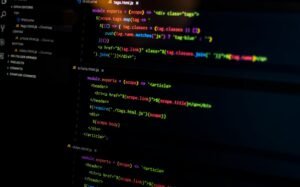Is Neural Network Part of Deep Learning?
Deep learning is a subfield of artificial intelligence (AI) that focuses on training machines to perform tasks without explicit instructions. It is a rapidly growing field that has shown immense potential in various domains such as image recognition, natural language processing, and autonomous driving. At the core of deep learning algorithms are neural networks, which mimic the structure and functionality of the human brain. But is a neural network really a part of deep learning? Let’s delve deeper into this question and explore the relationship between neural networks and deep learning.
Key Takeaways
- Deep learning is a subset of AI that uses neural networks to process and analyze data.
- Neural networks are a fundamental component of deep learning algorithms.
- Deep learning involves training neural networks with large amounts of data.
- Deep learning algorithms can automatically learn and extract meaningful patterns from data.
Neural networks are interconnected systems of nodes, known as artificial neurons or units, that are organized into layers. Each neuron takes input, applies a mathematical function to it, and produces an output. These outputs are then used as inputs for other neurons in subsequent layers, allowing information to flow through the network. Multiple layers of artificial neurons form a deep neural network, which is the backbone of deep learning algorithms.
**One interesting aspect of neural networks is that they can learn and adapt by adjusting the weights and biases of the connections between neurons during a training process**. This training process involves feeding the neural network with a large amount of labeled data so that it can learn to make accurate predictions or classifications. By iteratively adjusting the network’s parameters, such as the weights and biases, the neural network can optimize its performance and improve its ability to generalize from the training data to new, unseen examples.
In deep learning, neural networks are used to automatically learn and extract complex representations and features from raw data. Instead of manually engineering specific features, deep learning algorithms can learn hierarchical representations of the input data, discovering multiple levels of abstraction along the way. This ability to automatically learn meaningful features from data is one of the key advantages of deep learning compared to traditional machine learning approaches.
**It is worth noting that deep learning models can be incredibly powerful, but they also require a substantial amount of computational resources to train**. Deep neural networks often have millions or even billions of parameters, which necessitates using specialized hardware, such as graphics processing units (GPUs) or tensor processing units (TPUs), to accelerate the training process. The availability of massive datasets and advances in parallel computing have been instrumental in driving the progress and success of deep learning in recent years.
Tables
| Deep Learning Framework | Popular Applications |
|---|---|
| TensorFlow | Image recognition, speech recognition, natural language processing |
| PyTorch | Computer vision, generative models, reinforcement learning |
| Keras | Neural architecture search, transfer learning, text generation |
| Pros | Cons |
|---|---|
| + Excellent at learning complex patterns and features from data | – Requires a large amount of labeled training data |
| + Can automatically handle feature extraction and representation learning | – Computationally intensive and requires specialized hardware |
| + Enables breakthroughs in various fields, such as healthcare and self-driving cars | – Interpretability and explainability can be challenging |
| Artificial Neural Network | Deep Neural Network | |
|---|---|---|
| Structure | Interconnected neurons in at least three layers (input, hidden, output) | Multilayer neural networks with many hidden layers |
| Functionality | Predictions, classifications, data processing | Complex feature extraction, representation learning |
| Applications | Machine learning, cognitive tasks | Image recognition, natural language processing, autonomous driving |
Deep learning has revolutionized the field of AI and has fueled many breakthroughs in various domains. *Its ability to automatically learn and extract complex patterns from data has made it a powerful tool in tasks such as image recognition, natural language processing, and autonomous driving*. By leveraging neural networks as the fundamental building blocks, deep learning algorithms have demonstrated remarkable capabilities in tackling complex problems that were once deemed difficult or even impossible for machines to solve.
So, to answer the question: yes, **neural networks are an integral part of deep learning**. They form the basis upon which deep learning algorithms are built and allow machines to learn from data and make intelligent predictions. As deep learning continues to advance, we can expect neural networks to play an increasingly important role in shaping the future of AI and its applications.

Common Misconceptions
Neural Networks and Deep Learning
There are several common misconceptions when it comes to understanding the relationship between neural networks and deep learning. Many people mistakenly believe that a neural network is the same as deep learning, but this is not the case.
- Neural networks and deep learning are not interchangeable terms.
- Deep learning is a subfield of machine learning, which uses neural networks as one of its key tools.
- Deep learning involves training large and complex neural networks with multiple layers of hidden units.
Another misconception is that neural networks and deep learning are recent advancements in the field of artificial intelligence. While they have gained significant attention in recent years, the basic concepts and ideas behind neural networks have been around for several decades.
- Neural networks were first introduced in the 1940s and 1950s.
- Deep learning, as we know it today, has its roots in 1980s research on artificial neural networks.
- Advancements in computing power and availability of large datasets have contributed to the resurgence in interest and progress in neural networks and deep learning.
One misconception is that deep learning always outperforms other machine learning approaches. While deep learning has achieved remarkable results in various domains, it is not a one-size-fits-all solution and may not always be the best approach for a given problem.
- Deep learning requires a substantial amount of annotated training data to be effective.
- For problems with limited available data, other machine learning approaches may be more suitable.
- The interpretability of models generated by deep learning algorithms can also be a challenge in some applications.
Many people also believe that neural networks and deep learning completely mimic the human brain. While neural networks are inspired by the structure and functioning of the human brain, they are still far from achieving the complexity and capabilities of the human brain.
- Neural networks lack the same level of flexibility, adaptability, and generalization abilities as the human brain.
- The functioning of neural networks is based on simplified mathematical models of neurons, which differ from biological neurons.
- Attempts are being made to develop more biologically plausible neural networks, but the current state of deep learning models does not accurately replicate the full capabilities of the human brain.

Is Neural Network Part of Deep Learning?
Neural networks and deep learning are often used interchangeably, but they are not exactly the same thing. Neural networks are a computational model inspired by the human brain’s structure and function, while deep learning is a specific type of machine learning that utilizes neural networks with multiple layers. In this article, we will explore the relationship between neural networks and deep learning through ten insightful examples.
Considering the Innovation
The following tables highlight significant innovations in the field of neural networks and deep learning:
1. Classic Neural Networks
| Year | Innovation |
|---|---|
| 1958 | Perceptron is developed by Frank Rosenblatt. |
| 1965 | Backpropagation algorithm is introduced. |
2. Deep Learning Breakthroughs
| Year | Innovation |
|---|---|
| 2006 | Geoffrey Hinton’s team demonstrates that deep neural networks can surpass other machine learning techniques. |
| 2012 | AlexNet wins the ImageNet Large Scale Visual Recognition Challenge, marking a milestone for deep learning in computer vision. |
Examining Neural Network Architectures
The next set of tables explores different neural network architectures used in deep learning:
3. Feedforward Neural Network
| Architecture | Description |
|---|---|
| Single Layer Perceptron | The simplest form of neural network with input and output layers only. |
| Multi-Layer Perceptron (MLP) | A neural network with one or more hidden layers between the input and output layers. |
4. Convolutional Neural Network (CNN)
| Architecture | Description |
|---|---|
| LeNet-5 | One of the first successful CNN architectures, used for handwritten digit recognition. |
| ResNet | A deeper CNN architecture that introduced residual connections to improve gradient flow. |
Analyzing Deep Learning Applications
The following tables showcase real-world applications of deep learning:
5. Natural Language Processing (NLP)
| Application | Example |
|---|---|
| Machine Translation | Google’s Neural Machine Translation system translates text between languages. |
| Sentiment Analysis | Deep learning models can categorize text sentiment as positive, negative, or neutral. |
6. Computer Vision
| Application | Example |
|---|---|
| Object Detection | The YOLO (You Only Look Once) algorithm can simultaneously detect and classify multiple objects in an image. |
| Facial Recognition | DeepFace, developed by Facebook, can recognize faces with remarkable accuracy. |
Exploring Training Methods
The final set of tables dives into various training methods employed in deep learning:
7. Supervised Learning
| Method | Description |
|---|---|
| Stochastic Gradient Descent (SGD) | A popular optimization algorithm that uses a random subset of training data for each iteration. |
| Adam | An adaptive optimization algorithm that combines ideas from RMSprop and momentum. |
8. Unsupervised Learning
| Method | Description |
|---|---|
| Autoencoders | Neural networks that learn to reconstruct input data, often used for dimensionality reduction. |
| Generative Adversarial Networks (GANs) | Comprising a generator and discriminator network, GANs can generate realistic synthetic data. |
9. Reinforcement Learning
| Method | Description |
|---|---|
| Q-Learning | An off-policy, model-free approach commonly used for solving Markov decision processes. |
| Actor-Critic | A hybrid model combining value-based and policy-based methods, allowing for continuous actions. |
10. Transfer Learning
| Method | Description |
|---|---|
| Pretraining and Fine-tuning | Transfer learning leverages pretraining on a source task to improve performance on a target task with limited data. |
| Domain Adaptation | Techniques used to train a model on a source domain and then adapt it to a related target domain. |
In conclusion, understanding the intricate relationship between neural networks and deep learning is essential to grasp the potential and impact of this dynamic field. These tables have shed light on the historical advancements, architectural diversity, application domains, and training methods associated with neural networks and deep learning.
Frequently Asked Questions
Is Neural Network Part of Deep Learning?




